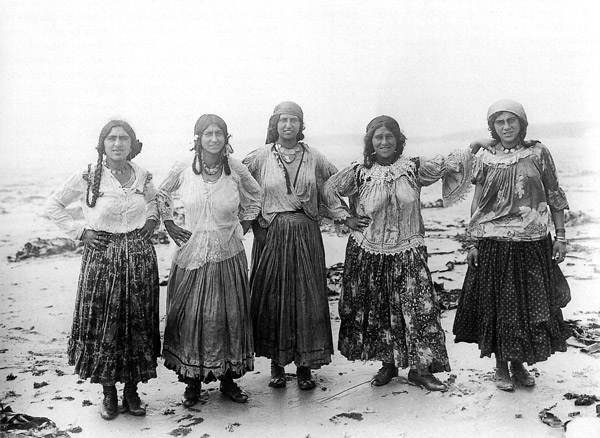B A C K T H E N
Gypsies

Gypsies pose on a kelp-strewn Biddeford beach, early 1900s. Their band was thought to have come from Brazil; American Gypsies frequently wintered in South America. Few American Gypsies in the early 1900s were likely natives, many having come to the United States in the ‘90s from Serbia, which had outlawed their wandering. Gypsyologist Irving Brown, writing in the early 1920s, classified the majority of American Gypsies as “Nomads,” with a minority being skilled metal-working “Coppersmiths.” Nomads lived largely on fortunetelling by the women, supplemented by horse trading by the men. The women wore scarlet silk scarves and necklaces of coins. American Gypsies, Brown wrote, were among the shyest, most nomadic, and least understood Gypsy groups in the world.
Gypsies were unwelcomed summer visitors in Maine, traveling in tatty caravans, towing a string of branded ponies and rickity horses. When word flashed through a village that the Gypsies were coming, excited housewives locked their doors, pulled the shades, and gathered in their children. Mary Ellen Chase of Blue Hill recalled that from behind drawn curtains, from haylofts, and from the tops of apple trees, thrilled children watched the Gypsies pass, absorbing every detail. That night, watches would be kept on henhouses. The next day, cautious village fathers might stay home from their business.
Gypsies camped in shady groves near a brook outside villages, fairgrounds, or resorts. The women were soon knocking at doors to tell fortunes. To a Gypsy, Brown explained, petty thievery was not a crime but a game, an abducted chicken being something found without it having been lost. Fortunetellers saw themselves as public servants, advising silly Gajo girls not to get married. Given that Gypsy men were notorious for their sharp horse trading, victims had little cause for complaint. Indeed, it was smugly surmised by Mainers that the reason the state was not more troubled by Gypsies was because even Gypsies could rarely best a Maine Yankee at horse trading.
Maine law gave county sheriffs the power to jail “all rogues, vagabonds, and idle persons...begging; persons using any subtle craft, jugglery, or unlawful games, or plays, or for the sake of gain pretending to have knowledge in physiognomy, palmistry, to tell destinies or fortunes or to discover lost or stolen goods; common pipers, fiddlers, runaways, drunkards, nightwalkers, rallers, brawlers, and pilferers,” and so on and so forth. After several days of encampment, Gypsies would commonly be told to move along.
Although children were warned that the Gypsies might kidnap them, so as to turn them into beggers, Gypsyologist Brown stated that there was no such authenticated case. (He conceded that young Gypsy women pretending to be captives, who begged for money so that they could escape, did little to improve the Gypsies’ reputation.)
A band of Gypsies that passed through here last week had with them a little blue-eyed child that did not in the least resemble his dusty companion. Suspicion was aroused that he might have been stolen and such proved to have been the case. It was a son of James Welch of 185 High Street, Nashua, N.H. Pursuit is now being made for the rascals and the little child will undoubtedly be rescued. When carried through here he was kept in a closed carriage and no one was permitted to see or speak to him. Our statutes do not provide a punishment severe enough to repay the cowardly curs for their dastardly conduct. — The [Kennebunkport] Wave, July 20, 1887.
Gypsy women’s sensational lack of inhibition concerning revealing their breasts originated from prohibitions regarding clothing worn above the waist by members of lower castes in India, the Gypsies’ ancient home. Their coin necklaces also reflected Indian fashion.
Text by William H. Bunting from A Days Work, Part 2, A Sampler of Historic Maine Photographs, 1860–1920, Part II. Published by Tilbury House Publishers, Thomaston Maine. 800-582-1899.
